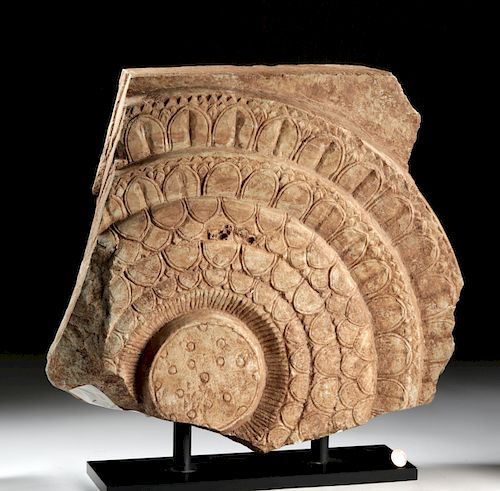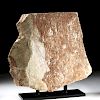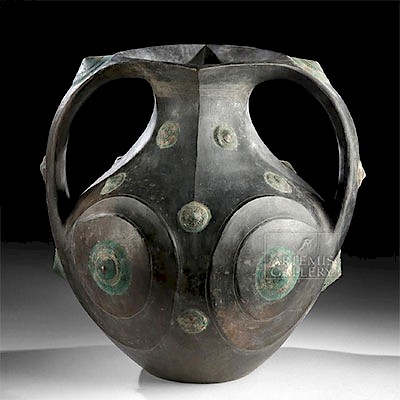Indian Limestone Relief Panel Fragment - Lotus Mandala
Lot 93
About Seller
Artemis Fine Arts
686 S Taylor Ave, Ste 106
Louisville, CO 80027
United States
Selling antiquities, ancient and ethnographic art online since 1993, Artemis Gallery specializes in Classical Antiquities (Egyptian, Greek, Roman, Near Eastern), Asian, Pre-Columbian, African / Tribal / Oceanographic art. Our extensive inventory includes pottery, stone, metal, wood, glass and textil...Read more
Categories
Estimate:
$5,000 - $7,000
Absentee vs Live bid
Two ways to bid:
- Leave a max absentee bid and the platform will bid on your behalf up to your maximum bid during the live auction.
- Bid live during the auction and your bids will be submitted real-time to the auctioneer.
Bid Increments
| Price | Bid Increment |
|---|---|
| $0 | $25 |
| $300 | $50 |
| $1,000 | $100 |
| $2,000 | $250 |
| $5,000 | $500 |
| $10,000 | $1,000 |
| $20,000 | $2,500 |
| $50,000 | $5,000 |
| $100,000 | $10,000 |
| $200,000 | $20,000 |
About Auction
By Artemis Fine Arts
Jul 11, 2019
Set Reminder
2019-07-11 10:00:00
2019-07-11 10:00:00
America/New_York
Bidsquare
Bidsquare : Ancient / Ethnographic / Americana
https://www.bidsquare.com/auctions/artemis-gallery/ancient-ethnographic-americana-4246
Discover ancient art from Egypt, Greece, Italy, and the Near East, as well as Asian, Pre-Columbian, Tribal, Fossils and Fine Art. Also featuring a wonderful collection from a prominent New York estate whose owners reside in the Van Wyck family's historic Lloyd Harbor waterfront home. Artemis Fine Arts info@artemisgallery.com
Discover ancient art from Egypt, Greece, Italy, and the Near East, as well as Asian, Pre-Columbian, Tribal, Fossils and Fine Art. Also featuring a wonderful collection from a prominent New York estate whose owners reside in the Van Wyck family's historic Lloyd Harbor waterfront home. Artemis Fine Arts info@artemisgallery.com
- Lot Description
Central Asia, India, Sattavahana Dynasty, ca. 2nd century CE. A fabulous and finely-preserved relief panel, meticulously carved and incised from chalky-white limestone, depicting a mandala-form lotus flower. The floral motif is comprised of a central disc decorated with 17 stamped circles on a central boss surrounded with a recessed groove boasting dozens of miniscule flutes, with three encircling rings of incised petals on the interior, and a pair of broad rings with additional petals and short serpentine scales around the exterior. The intricate stylization of this panel suggests that the relief was part of a Buddhist stupa of the Sattavahana Dynasty, similar to the monuments from Amaravati and Nagarjunakonda. Size: 17.25" W x 15.75" H (43.8 cm x 40 cm); 17.1" H (43.4 cm) on included custom stand.
The symbolism of the lotus was very important in Indian art, and is summarized beautifully by author Vidya Dehejia: "The lotus flower, which grew so abundantly in the Indian landscape and emerged fresh and pure from the hidden depths of muddy waters, was a pan-Indian symbol of purity. Buddhists adopted the symbolism of the lotus and equated its emergence from the murky depths to the manner in which the Buddha, born in this corrupt world, rose above it in his crystalline purity" ("Indian Art." 1997, p. 70).
Provenance: private East Coast, USA collection; ex-Dr. Gary Karch collection, Aventura, Florida, USA, acquired in the 1990s
All items legal to buy/sell under U.S. Statute covering cultural patrimony Code 2600, CHAPTER 14, and are guaranteed to be as described or your money back.
A Certificate of Authenticity will accompany all winning bids.
We ship worldwide and handle all shipping in-house for your convenience.
#146234This is a fragment of a larger relief panel. Small chips and abrasions to obverse, peripheries, and verso commensurate with age, with light softening to some finer details, and minor encrustations. Nice earthen deposits throughout. Old inventory label beneath bottom of stone.Condition
- Shipping Info
-
All shipping is handled in-house for your convenience. Your invoice from Artemis Gallery will include shipping calculation instructions. If in doubt, please inquire BEFORE bidding for estimated shipping costs for individual items.
-
- Buyer's Premium



 EUR
EUR CAD
CAD AUD
AUD GBP
GBP MXN
MXN HKD
HKD CNY
CNY MYR
MYR SEK
SEK SGD
SGD CHF
CHF THB
THB














